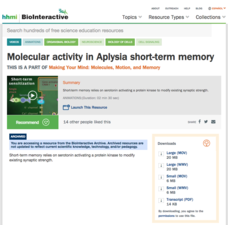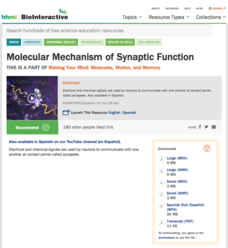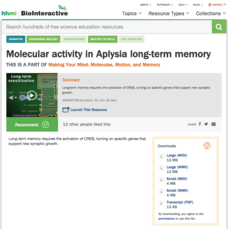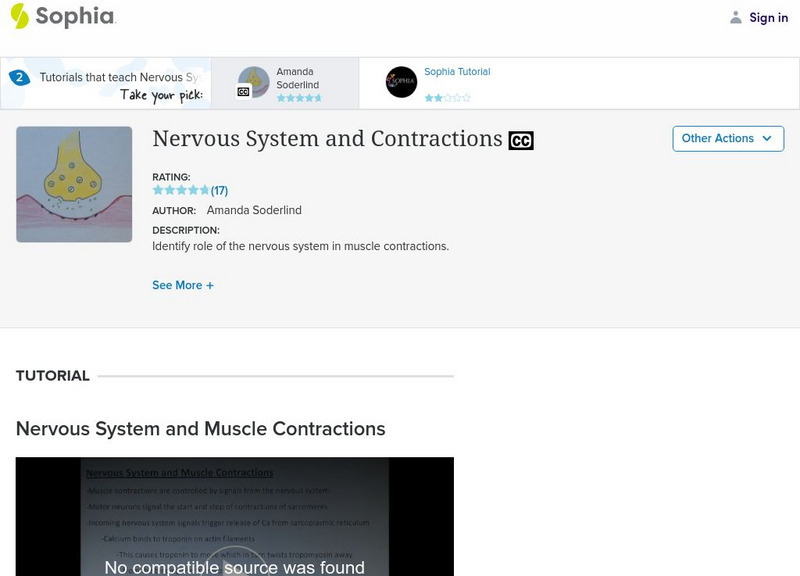Howard Hughes Medical Institute
Molecular Basis of Early Ltp (Short-Term Memory)
Digital amnesia: forgetting information one easily finds online. Learn how our brains move information into short-term memory at the molecular level with a short animation sure to make a memorable impression. Viewers observe a...
Howard Hughes Medical Institute
Molecular Activity in Aplysia Short-Term Memory
Scientists have yet to find the limit on the human brain's capacity for memory storage, so the potential is limitless! An animated video demonstrates how the brain places information in short-term memory. Viewers observe the...
Howard Hughes Medical Institute
Molecular Mechanism of Synaptic Function
Neurons don't touch each other, but they still communicate. Observe the process of both electrical and chemical signals used by neurons to share information. Hear exactly what triggers each step of the reaction as you view an animation...
Howard Hughes Medical Institute
Motor Cabal Toxins Block Motor Neuron Synapses
Cone snails release four different toxins, each capable of paralyzing a fish. An animation demonstrates that the toxins work independently, and then explains the impact of this redundant system on the nervous system.
Howard Hughes Medical Institute
Molecular Activity in Aplysia Long-Term Memory
How does information move into long-term memory? Scholars view the process at the molecular level with an animation. They learn about synaptic growth and how specific genes become active.
Howard Hughes Medical Institute
Autism and the Structure and Function of Synapses
Take autism awareness in your class to a whole new level. Scholars watch a short video to discover how autism affects the brain. The narrator discusses the effects of altered proteins on neural synapses and the role the nucleus plays in...
Crash Course
Memory: Crash Course Study Skills #3
It can be frustrating to forget information that you need later on, but the brain is only meant to take on so much data at a time. A video from a longer playlist about study skills discusses the details of memory, including the...
TED-Ed
How Do Drugs Affect the Brain?
Injection, taking a pill, or inhaling are the three main ways to administer a drug. But how do these drugs affect the brain? Watch a video that explains how neurons use neurotransmitters to communicate to one another in the brain.
TED-Ed
What Does Lead Poisoning Do To Your Brain?
Despite government regulations and improved housing quality, lead poisoning is still an issue today. But what are the implications of lead exposure to a person's brain and neural activity? Learn more in a video that uses animation to...
Crash Course
The Nervous System – Synapses! (Part 3)
The narrator of this short video breaks down synapses and how they work in video number 10 in a series of 47 about the human body. It specifically focuses on electrical and chemical synapses and how they work, and ends by exploring...
Crash Course
Sympathetic Nervous System
The sympathetic nervous system's job is to prepare the body in situations that threaten your survival. Video 14 in a series of 47 about the body specifically focuses on the sympathetic nervous system and stress. The narrator explains how...
TED-Ed
Why Elephants Never Forget
They say elephants never forget, but why exactly is that? Find out with this enlightening video as it explains the neuroscience behind the amazing intelligence of these giant mammals.
PBS
Pbs Learning Media: Crash Course Anatomy and Physiology: The Nervous System, Part 3: Synapses
We continue our tour of the nervous system with a look at synapses and the crazy stuff cocaine does to your body. [10:56]
Sophia Learning
Sophia: Nervous System and Contractions: Lesson 1
This lesson will investigate the role of the nervous system in muscle contractions. It is 1 of 4 in the series titled "Nervous System and Contractions."
Sophia Learning
Sophia: Neuron Communication Synapses and Neurotransmitters
This lesson will define neurotransmitter, synapse, and receptor sites and explain their functions in neural impulses and types of neurotransmitters,.
National Science Foundation
National Science Foundation: Mysteries of the Brain: Thinking Brain
A neuroscientist explains synaptic processes in the brain and how they enable learning and memory. [4:49]
Crash Course
Crash Course A&p #10: The Nervous System Part 2 Synapses!
We continue our tour of the nervous system with a look at synapses and the crazy stuff cocaine does to your body. [10:57]
Khan Academy
Khan Academy: Nervous and Endocrine Systems: Anatomy of a Neuron
Learn about neurons, the specialized cells that transmit and receive electrical signals in the body. [6:12]
Khan Academy
Khan Academy: How to Grow My Brain
Forty years ago, we seemed to know more about the moon than we did about how our own brains work and grow. Not anymore! Watch this video to see how the brain works and grows? [3:12]
Khan Academy
Khan Academy: Types of Neurotransmitter Receptors
Learn about two different types of neurotransmitter receptors - ionotropic and metabotropic. [6:36]
Khan Academy
Khan Academy: Synapse Structure
Synapses are where neurons contact and communicate with their target cells. This video explains the structure and types of synapses using diagrams. [6:50]
BSCS Science Learning
Bscs: Drug Abuse Segment 2
This video is part 2 of a series of videos on drug abuse, addiction, and the adolescent brain. This video explains the role of the brain in drug addiction. [14:01]
Sophia Learning
Sophia: Neurotransmitters: Lesson 1
This lesson will describe neurons communicate when sending a signal through the nervous system. It is 1 of 4 in the series titled "Neurotransmitters."




















